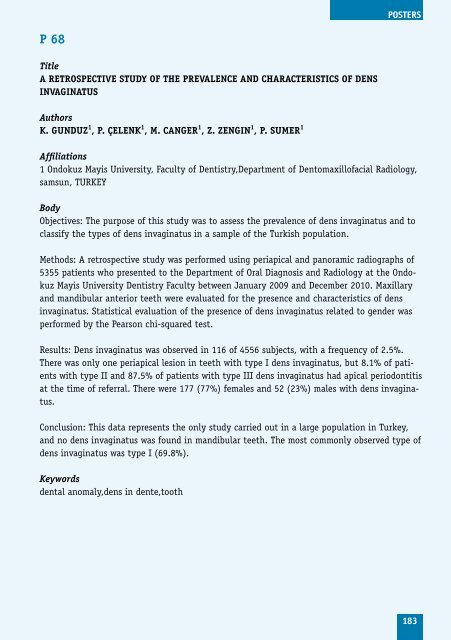Program including abstracts as pdf available here
Program including abstracts as pdf available here
Program including abstracts as pdf available here
Create successful ePaper yourself
Turn your PDF publications into a flip-book with our unique Google optimized e-Paper software.
P 68<br />
Title<br />
A RETROSPECTIVE STuDy OF THE PREVALENCE AND CHARACTERISTICS OF DENS<br />
INVAGINATuS<br />
Authors<br />
K. GuNDuz 1 , P. ÇELENK 1 , M. CANGER 1 , z. zENGIN 1 , P. SuMER 1<br />
Affiliations<br />
1 Ondokuz Mayis University, Faculty of Dentistry,Department of Dentomaxillofacial Radiology,<br />
samsun, TURKEY<br />
Body<br />
Objectives: The purpose of this study w<strong>as</strong> to <strong>as</strong>sess the prevalence of dens invaginatus and to<br />
cl<strong>as</strong>sify the types of dens invaginatus in a sample of the Turkish population.<br />
Methods: A retrospective study w<strong>as</strong> performed using periapical and panoramic radiographs of<br />
5355 patients who presented to the Department of Oral Diagnosis and Radiology at the Ondokuz<br />
Mayis University Dentistry Faculty between January 2009 and December 2010. Maxillary<br />
and mandibular anterior teeth were evaluated for the presence and characteristics of dens<br />
invaginatus. Statistical evaluation of the presence of dens invaginatus related to gender w<strong>as</strong><br />
performed by the Pearson chi-squared test.<br />
Results: Dens invaginatus w<strong>as</strong> observed in 116 of 4556 subjects, with a frequency of 2.5%.<br />
T<strong>here</strong> w<strong>as</strong> only one periapical lesion in teeth with type I dens invaginatus, but 8.1% of patients<br />
with type II and 87.5% of patients with type III dens invaginatus had apical periodontitis<br />
at the time of referral. T<strong>here</strong> were 177 (77%) females and 52 (23%) males with dens invaginatus.<br />
Conclusion: This data represents the only study carried out in a large population in Turkey,<br />
and no dens invaginatus w<strong>as</strong> found in mandibular teeth. The most commonly observed type of<br />
dens invaginatus w<strong>as</strong> type I (69.8%).<br />
Keywords<br />
dental anomaly,dens in dente,tooth<br />
POSTerS<br />
183


